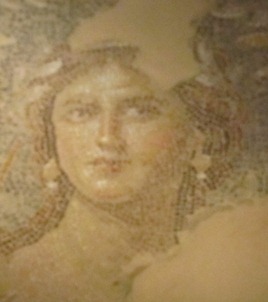Zippori
and Akko
A
feast of mosaic and fortifications: that is how I could summarize the last day
of the study tour to Galilee and beyond. The visit to Zippori (or Sepphoris),
some 7 kilometers away from Nazareth, and to Akko, on the Mediterranean Sea,
proved to be an excellent conclusion to a tour which gave us a great glimpse at
the richness and the beauty of this region in Israel.
Zippori
Excavations
in Zippori have brought to light a magnificent city. Remains include a system
of streets, public buildings, dwellings, a theatre, a central market,
bathhouses, a synagogue and churches. Most of these remains date back to the
Roman and the Byzantine periods. The historian Josephus Flavius described it as
“the ornament of all Galilee”.
 |
| An amazing mosaic from the Nile Room, Zippori. |
Zippori
begins to get its present splendor towards the end of the second century BC. In
the first century BC, the city was alternatively governed by the Romans and by
Herod the Great, when he was Governor of Galilee. During this time, Zippori was
the capital of Galilee. In 4 BC (that is around the time when the Holy Family
made their way to Nazareth from Egypt), the Jews revolted against the Romans
and captured Zippori. However, the Romans quelled the rebellion and burned the
city, selling its Jewish inhabitants into slavery. The city later came under
the rule of Antipas, Herod’s son, who rebuilt and fortified Zippori. Although
most of the splendor that could be admired today by visitors goes back to the
third century AD, Zippori was being rebuilt again during the childhood and
young age of Jesus. So we could easily imagine Joseph, and later on, Jesus with
him commuting to this city to seek for work there. Some scholars speculate that
Joseph may have worked as a tekton
(or “builder”) in the construction of Zippori.
 |
| Nazareth as seen from Zippori: some 7 kilometers away |
Zippori
was also a center of Jewish life in the 2nd century. The Sanhedrin convened
there for a time and it was the birthplace of the Mishnah, the first written
codification of Jewish oral law.
There
is truly a feast of great-quality mosaics in several rooms of the site as well
as in the Synagogue. The Nile House is an amazing example of this: here the
floors of the building were decorated with colourful mosaics. The largest of
the floors was adorned with a spectacular mosaic depicting the celebrations
held in Egypt when the Nile overflowed.
Another
example is Orpheus House, where Orpheus, the divine musician is depicted.
Yet
another example is the Dionysius House. In the dining hall of the house, the
floor depicts in mosaic the life of Dionysius, the god of wine, and his
worship. Here, there is also a mosaic of a face of a woman. She has been dubbed
as “the Mona Lisa of Zippori”.
 |
| The "Mona Lisa of Zippori" |
Within
the Synagogue, which was built towards the beginning of the fifth century AD,
has a mosaic containing more than 20 inscriptions in Greek and Aramaic, which
attests to the good cohabitation there existed between Jews and Greeks during
this time. The central space was richly decorated with Jewish motifs and
depictions of Bible stories.
Akko
This
city, which has been inscribed as a World Heritage by the Unesco, is a walled
city-port with a continuous settlement from the Phoenician period. The remains of
the Crusader town, dating from 1104 to 1291, lie almost intact, both above and
below today’s street level, providing an exceptional picture of the layout and
structures of the capital of the medieval Crusader Kingdom of Jerusalem. The
present city is characteristic of a fortified Ottoman town dating from the 18th
and 19th Centuries.
At
the time of the New Testament, this city was called Ptolemais. St Paul makes a one-day
stop there, greeting the believers that lived in the city (Acts 21, 7), before
proceeding to Caesarea. The city also features a number of times in the books
of the Maccabees (for example, 5,15.22.55; 10,1.39.56-58.60 etc).
During
the Crusade period, when it became the capital of the Latinate Kingdom of
Palestine, there were four Military Orders which had their headquarters there:
The Order of St John, better known as the Order of Malta, the Templar Order,
the Teutonic Order and the Order of St Lazarus. Until now, the two headquarters
discovered were those belonging to the Order of St John and the Templars. There
are series of majestic fortifications overlooking the Mediterranean Sea, of
underground tunnels and storerooms. Stunning is the Council Room of the Order
of St John, normally referred to as the Refectory. Akko received ships from
Amalfi, Genoa, Pisa and Venice. St Francis of Assisi and Marco Polo were among
the guests in the knights’ dining halls.
 |
| The Council Hall (Refectory) of the Order of St John at Akko |
 |
| Akko: Bell Tower, Christian Belfry, Minaret and the harbour |
 |
| The Akko Souq full of activity |
The harbour then with a most refreshing view of the blue sea of the Mediterranean has brought to me vivid memories of Malta … as beautiful and much more!
 |
| Akko, the Sea and Me |




No comments:
Post a Comment